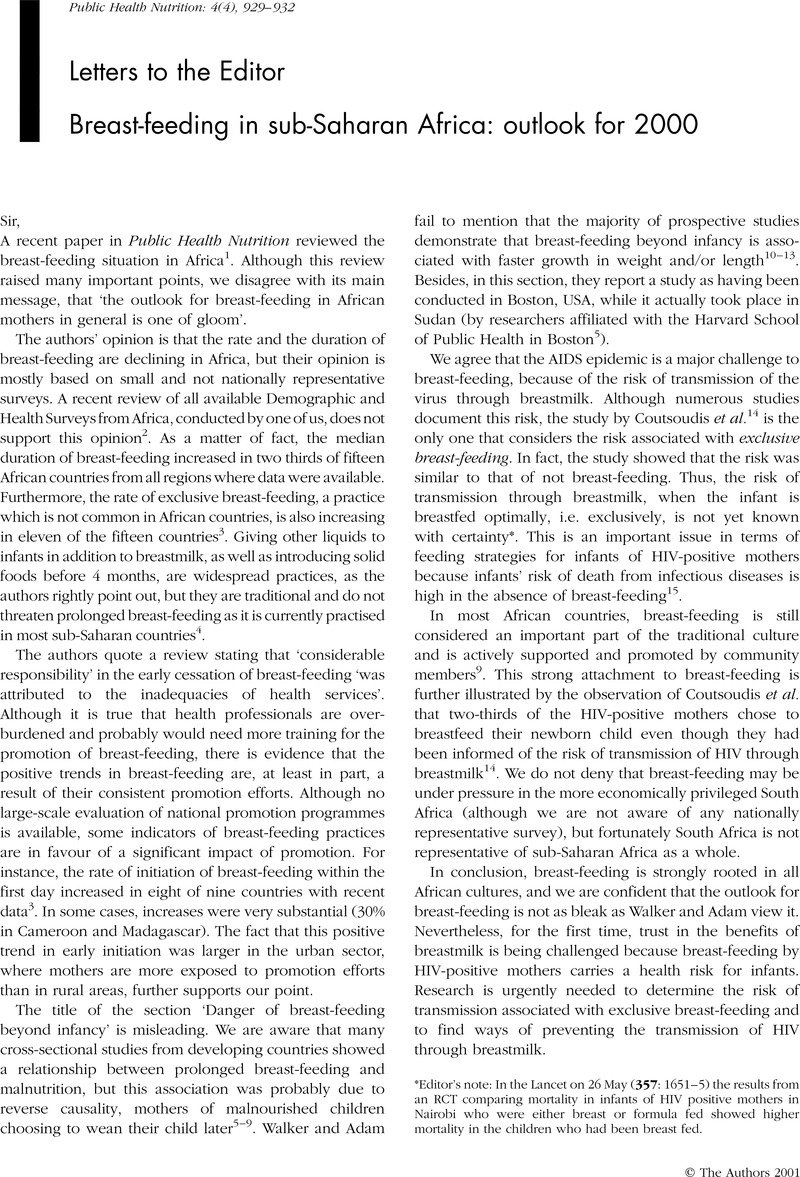No CrossRef data available.
Article contents
Breast-feeding in sub-Saharan Africa: outlook for 2000
Published online by Cambridge University Press: 02 January 2007
Abstract
An abstract is not available for this content so a preview has been provided. As you have access to this content, a full PDF is available via the ‘Save PDF’ action button.

- Type
- Letters to the Editor
- Information
- Copyright
- Copyright © CABI Publishing 2001
References
1Walker, ARP, Adam, FI. Breast-feeding in sub-Saharan Africa: outlook for 2000. Publ. Health Nutr. 2000; 3: 285–92.CrossRefGoogle ScholarPubMed
2Dop, MC, Simondon, KB. Letter to the Editor. Public Health Nutr. 2001; 4: 929–932.CrossRefGoogle Scholar
3Dop, MC. Breastfeeding in Africa: positive trends challenged by the AIDS epidemic. Cahiers Santé (forthcoming). In French.Google Scholar
5Bellamy, C. The State of the World's Children 1998. UNICEF, Oxford: Oxford University Press, 1998.Google Scholar
6Bellamy, C. The State of the World's Children 2001. UNICEF, New York: United Nations Publications, 2001.Google Scholar
7Moodley, J, Linley, L, Saitowitz, R. A review of the literature on breastfeeding – policy and research issues. S. Afr. Med. Journ. 1999; 89: 681–7.Google Scholar
8Kaufman, JS, Asuzu, MC, Rotimi, CN, Johnson, OO, Owoaje, EE, Cooper, RE. The absence of adult mortality data for sub-Saharan Africa: a practical solution. Bull. World Health Organ. 1997; 75: 389–95.Google ScholarPubMed
9Bekele, A, Berhane, Y. Magnitude and determinants of bottle feeding in rural communities. East Afr. Med. Journ. 1999; 76: 516–9.Google ScholarPubMed
10Costello, A, Sachdev, HS. Protecting breast feeding from breast milk substitutes. BMJ 1998; 316: 1103–4.CrossRefGoogle ScholarPubMed
11Taylor, A. Violations of the international code of marketing of breast milk substitutes: prevalence in four countries. BMJ 1998; 316: 1117–22.CrossRefGoogle ScholarPubMed
12Ferriman, A. WHO accused of stifling debate about infant feeding. BMJ 2000; 320: 1362.CrossRefGoogle ScholarPubMed
13Ojofeitimi, EO, Esimai, OA, Owolabi, OO, Oluwabusi, A, Olaobaju, OF, Olanuga, TO. Breast feeding practices in urban and rural health centers: impact of baby friendly hospital initiative in Ile-Ife, Nigeria. Nutr. Health 2000; 14: 119–25.CrossRefGoogle Scholar
14Maik, ANJ, Cutting, WAM. Breast feeding: the baby friendly initiative. BMJ 1998; 316: 1518–9.Google Scholar
15Boulle, A, Bletcher, M, Burn, A. Hospital restructuring South African Health Review, 2000. Durban: Health Systems Trust, 2000; Chapter 11, 231–50.Google Scholar
17Newell, ML. Infant feeding and HIV-1 transmission. Lancet 1999; 354: 442–3.CrossRefGoogle ScholarPubMed
18Latham, MC, Preble, EA. Appropriate feeding methods for infants of HIV infected mothers in sub-Saharan Africa. BMJ 2000; 320: 1656–9.CrossRefGoogle ScholarPubMed
19Zwi, K, Soderlund, N. Commentary: The feeding debate is still unresolved and of secondary importance. BMJ 2000; 320: 1659–60.Google Scholar
20Izindaba, . Half of Botswana's deaths from AIDS. S. Afr. Med. Journ. 90: 2000; 1170–1.Google Scholar


